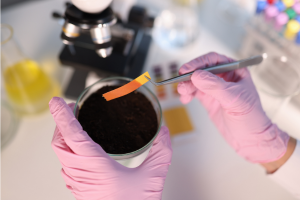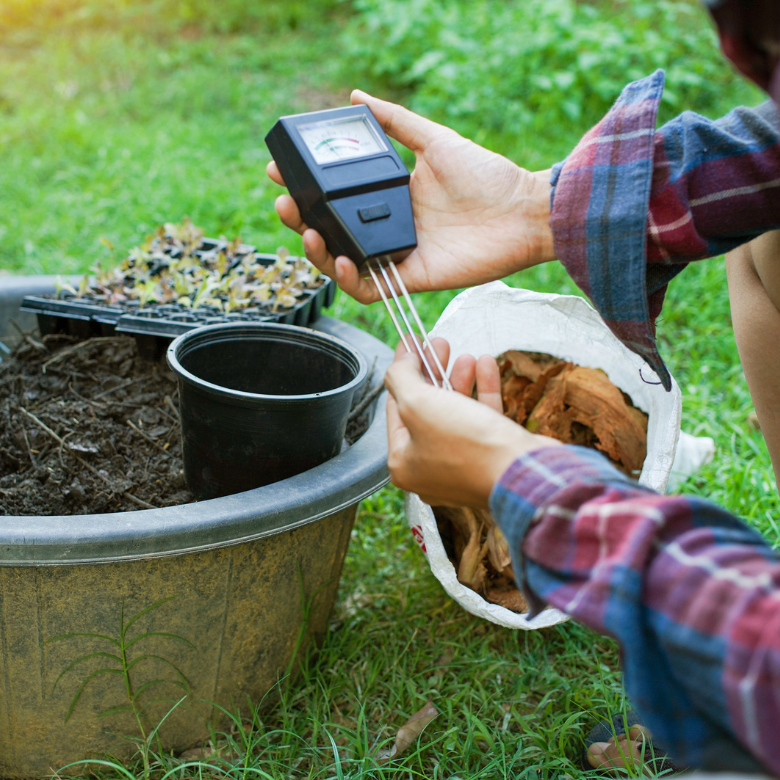Owners of orchards, farmland and gardens are currently facing a number of problems that are largely due to the climate change that accompanies us. However, sudden frosts and periods of drought do not only harm plants that have already had time to sprout. Drastic changes in temperature also affect soil pH. Meanwhile, its pH is crucial to the quality of the crop. The following article will show you how it can be measured and then increased or decreased.

What is soil pH?
The pH scale is very important not only for soil, but also for laboratory tests or skin care. This is because it determines the level of acidity and alkalinity of various solutions. We use it to determine the concentration of H+ ions, e.g. in a substrate.
Once we know the pH indicators for the soil we are interested in, we can use this information in a number of ways. As a general rule, a soil pH of less than 6.5 indicates acidity, a pH between 6.5 and 7.2 is considered neutral, and above 7.2 is considered alkaline. By knowing what pH we are dealing with, we can anticipate the risk of a chemical reaction and choose the appropriate measures to protect our plants. This is because some of them have acidifying properties, while others increase the pH of the soil.
There are many factors that influence the changes seen in soil pH tests. Before discussing them, however, it is useful to know that different soil types are characterised by specific pH values. This is because it depends on the rocks from which the soil was formed. We divide them precisely into acidic (e.g. volcanic) and basic (e.g. limestone), which can take on a slightly acidic or alkaline reaction because they are rich in calcium, magnesium and sodium ions.
Effects of inadequate soil pH
We already know that the value that a soil pH meter will indicate to us depends, among other things, on the origin of the soil, but can also change as a result of many factors. The pH index is influenced by both human activities and natural processes, which include:
- large amounts of rainfall and a humid climate,
- the process of mechanical breakdown of rocks, occurring under the action of solar energy, water and air,
- microbial action (e.g. oxidation).
Man also has a significant impact on soil pH formation through, among other things, environmentally destructive activities such as deforestation and incompetent crop management.
The processes listed above overwhelmingly lead to soil acidification. The result can be:
- loss of stable rock structure,
- proliferation of bacteria and fungi,
- disruption of the plants’ uptake of mineral nutrients due to, among other things, a reduction in the root system,
- more frequent occurrence of mechanical damage to plants,
- penetration of heavy metals into crops.
Although most talk about the negative effects of soil acidification, too high a pH index is not beneficial either. Among other things, it can cause mineral malabsorption. It is also important to remember that the correct pH is one that allows plants to grow healthily, and each species is adapted to different conditions. Many crops are susceptible to acidification, but there are also some that require an acidic soil pH. These include, among others, certain berries.

How do you check the soil pH?
The most common way to test the pH is to use a soil pH meter. It is a device with a pointer that, when driven into the ground, allows us to determine the reaction based on the deviation of the pointer. Electrical meters with more accurate measurements are also increasingly common. They often also have additional functions, such as measuring humidity and sunshine levels.
There are also other methods to test the soil pH: mixing samples with distilled water, vinegar and baking soda and observing the reactions that then take place, using an acid meter or a modern scanner. However, each of these is subject to a large margin of error. If you want a specialised and accurate measurement of soil pH, you should submit samples to a laboratory.
It is worth bearing in mind that soil pH test results will vary. Due to the number of factors mentioned above that influence its acidification, measurements should be taken at least once a year.
How do you lower soil pH and when should you do it?
If the soil pH is too high, it should be acidified. Chemistry in the garden can help: the soil can be mixed with an acidifying fertiliser. Such properties are demonstrated by urea, among others. The measures used vary according to the type and amount of soil. In small gardens, homemade methods such as mixing soil with vinegar are sometimes sufficient.
Which fertilisers reduce soil pH?
If you plan to grow crops that require an acidic soil reaction, the alkalinity of the soil can be reduced using:
- nitrogenous fertilisers with ammonium sulphate,
- ammonium nitrate,
- urea,
- compound fertilisers in liquid or granular form.
How to raise the soil pH?
Much more common is the situation where, in order to achieve the correct soil pH, we need to reduce the acidity of the soil. It is worth doing this by using the right measures. Especially when dealing with plants that are extremely sensitive to acidity. Fertiliser lime 20W, for example, would be a good choice.
Which fertilisers increase soil pH?
The best remedy for acidified soil is lime in powdered or granulated form. Calcium carbonate, often enriched with magnesium, is most common in ready-to-use preparations. When to use lime to deacidify the soil? This is best done after the harvest or a few weeks before sowing the cereals. Polish farmers usually perform this treatment in early spring or late autumn.

Effect of soil pH on vegetation
You already know that the correct soil pH is essential for healthy plant growth. Its acid reaction is particularly unfavourable, but it all depends on the species, as you will see in a moment.
What is the importance of soil pH for vegetables?
The best soil pH for growing most vegetables is considered to be between 6.0 and 6.8, i.e. slightly acidic or neutral. Among others, sugar beet and most legumes require it. However, there are exceptions: potatoes and turnips do well in soil with a lower pH.
What is the correct soil pH for grass?
The pH of the soil for grass cultivation should be slightly acidic (5.5-6.5). Poland is dominated by soils with a low pH, which favours its growth.
What is the right soil pH for fruit trees?
Fruit trees have diverse requirements. Acidification should be avoided especially in the case of cherries, sweet cherries and plums. Apple and pear trees are doing slightly better. In their case, the soil pH should be between 5.0 and 6.5.
Appropriate soil pH value for conifers
Conifers do best with slightly acidic soil.
The importance of soil pH for other plants
The appropriate soil pH value should be verified for every plant, whether you have arable fields or a home garden. A range of 5.0-6.5 is considered the safest reaction in most cases, but it is worth considering the individual requirements of each. If you are unsure when and how to carry out field liming, acidification or soil pH measurement, use the other blog articles available on the PCC Group Product Portal or consult specialists.
- Sporek, M., Sporek K., Variability of the pH of soils, Proceedings of ECOpole 1.1/2 (2007): 249-252.
- https://www.acta-agrophysica.org/pdf-108118-38910?filename=Effect%20of%20pH%20and%20selected.pdf
- https://agro.icm.edu.pl/agro/element/bwmeta1.element.agro-article-7625577b-76a0-43ff-be7f-4afad40457ff
- Slawomir Gonet, Halina DSmal, Józef Chojnicki: Chemical properties of soils. In: Andrzej Mocek (ed.): Soil science. Published. I. Warsaw: Wydawnictwo Naukowe PWN, 2015
- Andrzej Mocek, Stanisław Drzymała: Genesis, analysis and classification of soils. Poznan: Wydawnictwo Uniwersytetu Przyrodniczego w Pozananiu, 2010